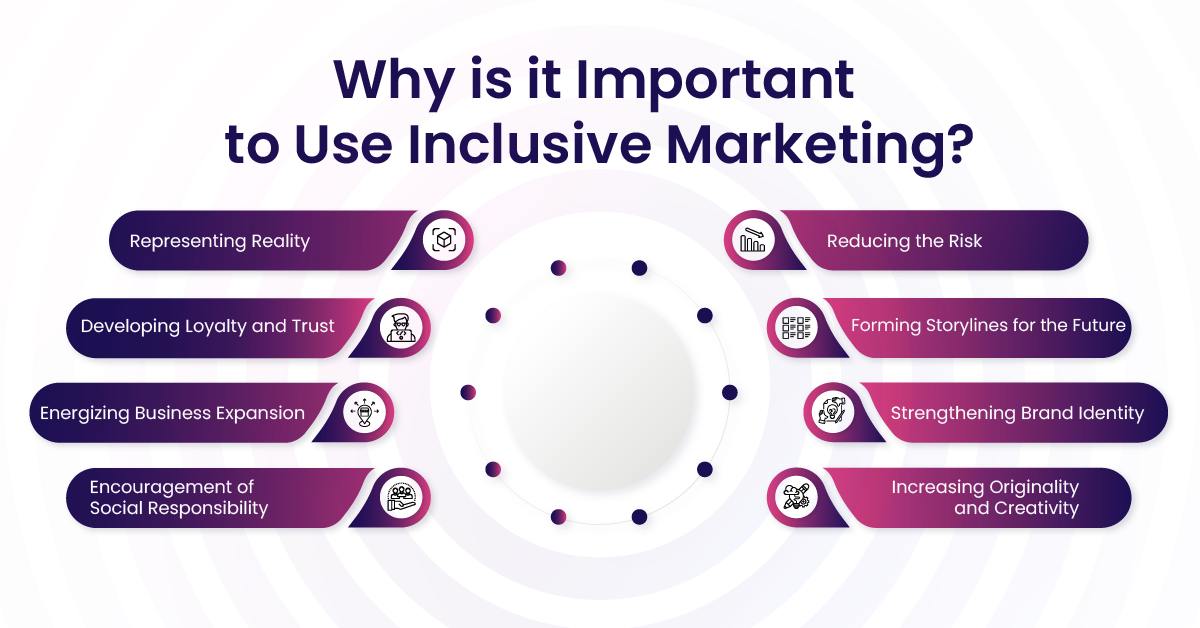5 min read

Adopting inclusive marketing strategies that accurately represent and interact with every member of their target audience is crucial for businesses in today’s diverse and connected world. Inclusive marketing goes beyond simply acknowledging diversity; it involves actively including and empowering individuals from different backgrounds, cultures, and identities. The significance of inclusive marketing, helpful implementation advice, and inspiring case studies from companies that have adopted this strategy will all be covered in this blog post.
Table of Contents
Introduction to Inclusive Marketing
In this section, we will introduce the concept of inclusive marketing strategy, its significance in today’s society, and why businesses should prioritize it. We will discuss how inclusive marketing fosters positive brand perception and drives business growth by connecting with a wider audience.
Five Inclusive Marketing Techniques
- A real reflection in the mirror.
- Be inclusive of all people.
- Spend some time comprehending
- Take care when using language and tone.
- Evaluation of intent versus effect
Why is it Important to Use Inclusive Marketing?

Inclusive digital marketing is a noble endeavor and a strategic necessity in today’s globalized world, where cultures collide and consumers have greater power than before. Beyond simple representation, inclusive marketing is important because it affects customer relationships, brand perception, and the very culture of contemporary business. Let us examine more closely the various factors that highlight its importance:
-
Representing Reality
Our world has diverse identities, experiences, and tales. By guaranteeing that brand narratives reflect this diversity, inclusive marketing helps to make brands seem more genuine and relatable. Advertising and marketing campaigns featuring real people give consumers a sense of validation and belonging.
-
Developing Loyalty and Trust
Customers who identify with a brand are more likely to support and remain devoted to it. By using inclusive marketing techniques, brands can communicate to their audience that they value, respect, and celebrate diversity. In addition to building trust, this also promotes long-term loyalty.
-
Energizing Business Expansion
In terms of the economy, various audiences represent a large and undiscovered market segment. By serving these audiences, brands can grow their consumer base, generate new revenue streams, and accelerate business growth.
-
Encouragement of Social Responsibility
Another indication of a company’s dedication to social responsibility is its use of inclusive marketing. It displays a company’s commitment to supporting diversity, dispelling myths, and building an inclusive society. A brand’s image and reputation can be greatly enhanced by sharing its values with consumers, which is becoming increasingly common today.
-
Increasing Originality and Creativity
Richer concepts and more creative solutions result from diverse viewpoints. Adopting inclusivity allows brands to access a wider spectrum of perspectives, experiences, and creative ideas, resulting in more innovative and powerful marketing campaigns.
-
Reducing the Risk
In the era of social media, inclusive marketing can serve as a buffer against brands that mislead consumers or disregard cultural differences. Brands can lessen the likelihood of negative press and backlash by ensuring their campaigns are thoroughly thought out, sensitive to cultural differences, and authentically representative.
-
Forming Storylines for the Future
Brands enormously impact the narratives that shape society. They can dispel long-held myths, shatter barriers, and establish new benchmarks for representation with inclusive marketing and organic lead generation. This promotes a more equal and inclusive society, in addition to helping the brand.
-
Strengthening Brand Identity
Including all brands in inclusive marketing can set you apart in a crowded market where many sell comparable goods and services. Brands that use it can differentiate themselves from the competition, connect more strongly with a wider range of consumer segments, and forge a distinctive identity.
Comprehending Your Audience
A marketing campaign should never be launched without first understanding your target audience. We will go over how to conduct in-depth market research in this section to learn more about your target audience’s varied needs, preferences, and experiences. We will investigate methods like focus groups, surveys, social listening, and data analysis to ensure your marketing initiatives are customized to appeal to various target market segments.
Authentic Representation in Visual Content
Visual content plays a significant role in marketing campaigns, and ensuring that it authentically represents diverse identities is essential. The significance of utilizing diverse models, actors, and imagery that truthfully represent a range of racial, ethnic, gender, age, and body types will be covered in this section. We will also explore the concept of stereotype avoidance and how to create inclusive visual content that celebrates individuality and promotes positive representation.
Language and Communication
Language holds immense power, and it is crucial to use inclusive and respectful language in all marketing communications. This section will discuss the significance of avoiding stereotypes, biases, and microaggressions in your messaging. We will provide guidelines for using gender-neutral language, avoiding cultural appropriation, and employing inclusive pronouns. By embracing inclusive language, businesses can create a welcoming environment for all individuals.
Collaborating with Diverse Influencers
Influencer marketing has become increasingly popular, but it is vital to collaborate with influencers who reflect the diversity of your target audience. The advantages of collaborating with influencers who represent diverse identities and backgrounds will be discussed in this section. We will provide
- tips for finding diverse influencers,
- establishing authentic relationships and
- co-creating content that resonates with their followers.
Inclusive Advertising Campaigns
Inclusive advertising campaigns can challenge societal norms and create a positive impact. This section will showcase successful examples of brands that have embraced inclusive marketing in their advertising. We will analyze their strategies, such as featuring diverse families, challenging beauty standards, or addressing social media marketing service issues. By highlighting these examples, readers will gain inspiration and actionable insights for their inclusive marketing campaigns.
Accessibility and Inclusivity in Digital Marketing
Digital marketing should be accessible to everyone, regardless of their abilities or disabilities. Web accessibility and inclusive design principles will be covered in this section. We will explore strategies for creating accessible websites, optimizing content for screen readers, and ensuring compatibility across different devices. By prioritizing accessibility among their digital marketing experts, businesses can demonstrate their dedication to inclusivity and expand their audience reach.
Engaging with Diverse Communities
Inclusivity extends beyond marketing campaigns; it involves continuously engaging with diverse communities. This section will discuss the significance of building relationships with different community organizations and supporting initiatives promoting diversity and inclusion. We will explore strategies for partnering with nonprofits, sponsoring events, or facilitating workshops that empower marginalized communities. Companies can cultivate trust and loyalty within their target audience by participating in these communities.
Measuring the Impact of Inclusive Marketing
To ensure the effectiveness of inclusive marketing strategies, it is essential to measure their impact. This section will cover important metrics to monitor, including sales data, customer feedback surveys, and engagement rates for various audience segments. We will also explore the importance of ongoing evaluation and iteration to improve inclusive marketing efforts.
Conclusion
To sum up, inclusive marketing is more than just a fad—it is a moral requirement for companies looking to succeed over the long haul in the diverse market of today. Through the application of the tactics discussed in this blog post, which include knowing your audience, representing yourself authentically in visual content, using inclusive language and communication, working with diverse influencers, creating inclusive advertising campaigns, being accessible in digital marketing, interacting with different communities, and tracking results, companies can enhance their relationship with their target market and promote an inclusive society.
Recall that adopting inclusive marketing calls for constant learning and adjustment. You may establish your brand as a pioneer in your sector and improve people’s lives simultaneously by giving diversity and inclusivity top priority in your marketing campaigns.
Published: January 4th, 2024








